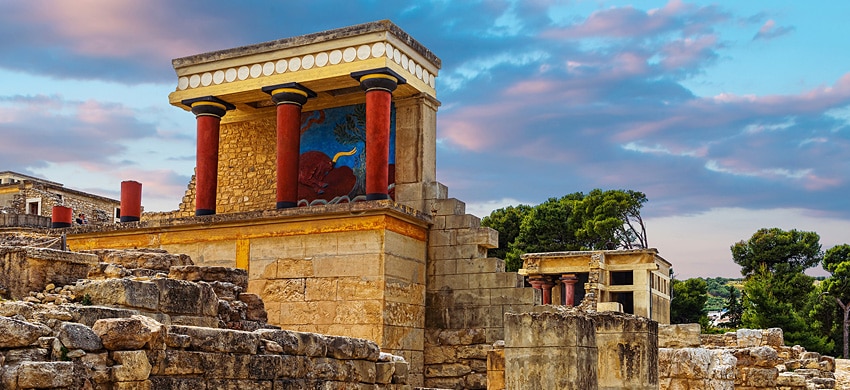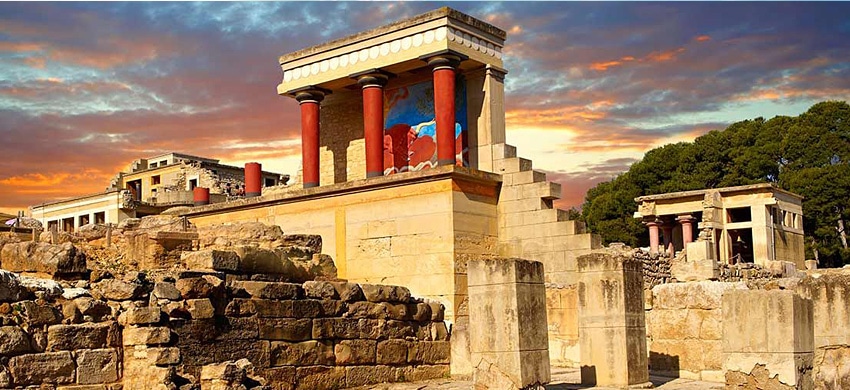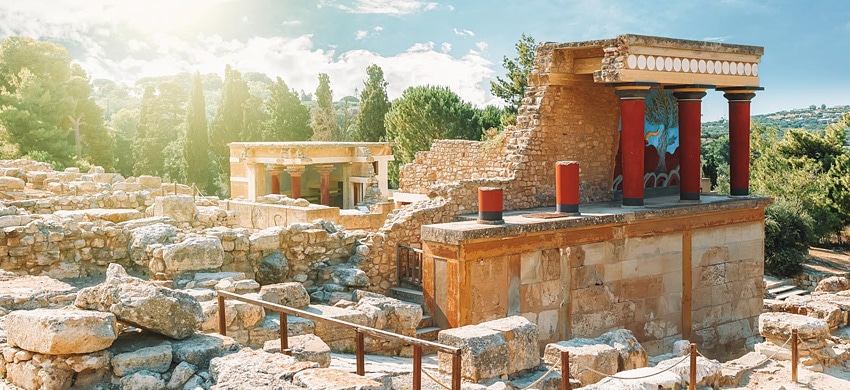
Political, economic and religious center, the Palace of Knossos was built around 1700 BC and is currently located about 6 km from the center of Heraklion, the capital of Crete. Cradle of the Minoan civilization, Knossos was a town that, surrounded by the river Kairatos, stood in a strategic position on the hill of Kefala but was not too far from the sea and the port of Heraklion.
This huge site stood on an area of about 22,000 m² and consisted of a central courtyard, where the gymnasts performed, around which was built a huge complex that included the royal and staff quarters, the halls of administrative officials, areas used for worship and receptions and the stores of various craftsmen.
Today you can walk through the ruins of this small citadel built by the Minoan people, one of the most interesting ancient civilizations, and admire the masterpieces that this had managed to achieve at the time.

The site of Knossos brings to light the architectural and artistic heritage of this civilization that can be admired not only in the majesty and grandeur of this small citadel, but also in the decoration of the rooms and objects that have been found in the vicinity of the area.
No traces have been found of walls built to protect the Palace of Knossos and the structure of the site seems to have been very intricate and difficult to reconstruct in its entirety. In the most eastern part there are the royal rooms and the workshops, while in the most western part there is the Small Palace, the House of Frescoes with finely decorated walls and the Villa of Dionysus, a private residence adorned with mosaics of great prestige.
Do not miss a visit to two important areas: the Throne Room and the Queen’s apartments. The Throne Room is bright red and here were found remains of a throne in alabaster plaster, while in the area of the Megaron of the queen were discovered wonderful frescoes, such as that of the “dolphins” and that of the “dancer”.
The apartments of the queen, moreover, were characterized by the presence of a bathroom really avant-garde for the time, which saw the presence of an advanced system of sewers and drains but also of large tanks that allowed to always have drinking water and hot.
Currently the frescoes that can be admired in Knossos are faithful reproductions and the originals of these masterpieces of Minoan art are now preserved in the Archaeological Museum of Heraklion.
You can buy your ticket online and save the queues at the ticket offices, literally taken by storm during the summer period; there are discounted tickets.
Alternatively, to find out all about the Palace of Knossos you can request an audio guide or have an experienced guide accompany you during your visit. The cost is a little higher than the entrance ticket and even buying one of the tickets below will save you time by avoiding standing in line at the ticket office.
If in addition to the visit of the archaeological site of Knossos you want to combine the ticket for the Archaeological Museum of Heraklion, buy a single ticket.
The Palace of Knossos is open daily from 8:30 am to 5:00 pm, last entry time at 4:30 pm. Closed on the following days: January 1, March 25, May 1, Easter Sunday, December 25 and 26.
The area of the archaeological site of Knossos is about 6 km (15 minutes) from the city of Heraklion and is therefore easily accessible by car or by taking the bus that always leaves from the city center.
Alternatively if there are more people, given the proximity of the site to Heraklion, it is possible to evaluate the use of a cab.

The Palace of Knossos that we can all see today is the result of works of reconstruction and restoration of a complex made by the Minoan civilization about two thousand years before Christ. What appears before our eyes is actually a real masterpiece: built on the ashes of a previous building, destroyed by an earthquake around 1700 BC, the current Knossos is said to be the place where the legendary King Minos lived and is said to have housed more than 12,000 people.
This magnificent archaeological site, built in the years when the Minoan civilization was at its peak, was then hit by another earthquake and partially destroyed. The first discoveries of these remains were made at the end of the nineteenth century by Minos Kalokairinos, an antiquarian of Heraklion, but then it was the English archaeologist Sir Arthur Evans to direct the restoration work, proposing a reconstruction of the complex that some define too arbitrary and not very faithful to the original.
Nowadays, Knossos is also famous for the stories and legends that connect it to characters such as Daedalus, Icarus, and the famous Minotaur. According to Greek mythology, King Minos asked Daedalus to build an intricate labyrinth in which to lock up the Minotaur, a ferocious being with the body of a man and the head of a bull.
The god Poseidon, in fact, had given to King Minos a beautiful white bull asking him to sacrifice it, the king, however, saw the beauty of this bull decided to keep it and sacrifice another. Poseidon, discovered what had happened, to punish him made the king’s wife, Pasiphae, fall in love with the bull and from their union was born the Minotaur.
Being a ferocious and cruel being, the Minotaur was locked up in a labyrinth and it was decided to send him seven girls and seven boys as sacrifice. Theseus was one of those seven young people arrived in Crete to enter the labyrinth as a sacrificial victim, the boy, however, with the help of Ariadne, daughter of Minos, entered the labyrinth unrolling behind him the famous “thread of Ariadne”. When Theseus came in front of the Minotaur, he killed him with his sword and then managed to get out of the labyrinth by following the thread he had unwound.
Today walking through the ruins of the archaeological site, where perhaps once these legendary stories took place, we can admire the charm and power of this civilization and what it was able to build thousands of years ago.
Knossos Palace is located 6 km from Heraklion, the main city of the island of Crete which also hosts the international airport, 38 km from Malia and 80 km from Rethymno.